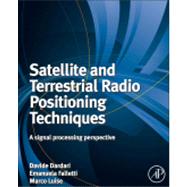Satellite and Terrestrial Radio Positioning Techniques

Satellite and Terrestrial Radio Positioning Techniques
- ISBN 13:
9780123820846
- ISBN 10:
0123820847
- Format: Paperback
- Copyright: 08/19/2016
- Publisher: Elsevier Science
New From $137.62
Sorry, this item is currently unavailable on Knetbooks.com
List Price $139.00 Save $1.38
New
$137.62
Print on Demand: 2-4 Weeks. This item cannot be cancelled or returned.
We Buy This Book Back!
Included with your book
Free Shipping On Every Order
Note: Supplemental materials are not guaranteed with Rental or Used book purchases.
Extend or Purchase Your Rental at Any Time
Need to keep your rental past your due date? At any time before your due date you can extend or purchase your rental through your account.
Summary
Information about the position of a user's mobile handheld (wireless) device allows a network operator to pinpoint the position of a customer in relation to their network infrastructure. This technology enables a multitude of applications in a wide range of fields: sensor networks, geographic information, location management, location-based billing, emergency services, location-based advertising, intelligent transportation, and leisure applications, among others. The availability of a ubiquitous, ever-available positioning system would allow the development of new opportunities and business models, creating innovative products and the delivery of highly personalized services.Location-aware applications are finally on the brink of revolutionizing the way in which people go about their business on a daily basis. Of the top 50 Android applications chosen by Google, about 1 in 7 was built using the GPS functionality. Nokia has developed GPS-enabled handsets, such as the N95, and navigation solution packages. And of course, the iPhone's location-aware APIs are being used by developers for all sorts of applications, allowing users to: Find businesses (restaurants, shops, etc.) or movie showtimes in their area, with reviews Log photographed locations to later geotag their photos with a GPX photo geotagging tool Find WiFi spots in their area Catalogue anything with a location, pictures and text - for example, while house hunting Find open job positions within a given radius of their location and apply directly from their phone Map their run, hike or daily commute without needing mobile reception or an address Display Wikipedia articles relevant to their current position Send out a 911 call with their exact current co-ordinates Remember where they parked their car!This book describes the state-of-the-art on positioning techniques, combining for the first time both satellite and terrestrial methods. Taking a signal processing approach, the book focuses on such techniques as signal tracking, parameter estimation and data post-processing and filtering, which are becoming the core of every positioning receiver. The first section is dedicated to the presentation of the different positioning solutions, both satellite and terrestrial, examining the different existing techniques used and discussing their limitations. The performance and accuracy of various methods and their fundamental bounds are evaluated, and new perspectives and algorithms are discussed. In keeping with the signal processing approach, one section discusses innovative technologies for wireless positioning, and another looks more closely at cognitive radio and cognitive positioning.Coverage is also given to the hot topics of co-operative positioning (CPS) and inertial navigation (INS). CPS provides a more reliable service over long distances, and can be used in an uncharted environment and in three dimensions, allowing users to navigate unfamiliar surroundings with ease. INS allows position location without the need for external references, making it immune to outside interference and therefore extremely useful for military applications on ships, aircraft, submarines and guided missiles.Feature: Combines satellite and terrestrial positioning techniques, using a signal processing approach.Benefit: Enables the development of higher quality, more flexible and effective products: for example, merging these two technologies will reduce the complexity and processing time taken to receive an accurate GPS location when using a satellite-terrestrial phone.Feature: Discusses the applicability of developed techniques to emerging standards, such as LTE Advanced or WiMAX II, through the issue of ranging measurement with








